Catocala antinympha
Catocala antinympha
kah-TOCK-uh-lahman-tih-NIM-fuh
(Hübner, [1823])
Ephesia antinympha
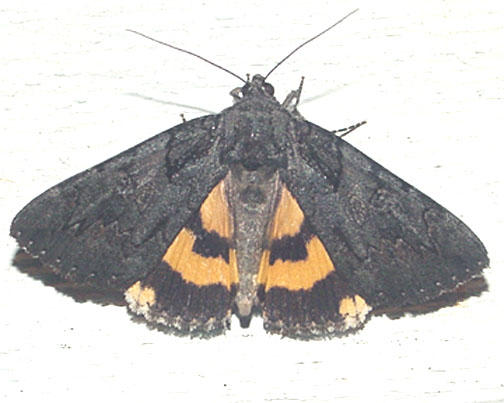
The Sweetfern Underwing, August 12, 2003,
by Tom Murray copyright.
This site has been created by
Bill Oehlke.
Comments, suggestions and/or additional information are welcomed by Bill.
| TAXONOMY:
Superfamily: Noctuoidea
Family: Erebidae, Leach, [1815]
Subfamily: Erebinae, Leach, [1815]
Tribe: Catocalini, Boisduval, [1828]
Genus: Catocala, Schrank, 1802
|
DISTRIBUTION:
The Catocala antinympha moth
(wingspan: 45-55mm) flies from Ontario
east through Quebec (common),
New Brunswick and
Nova Scotia (CNC has records for
Prince Edward
Island, but I have not seen it here as of yet) and as far west as
Saskatchewan (possibly in error).
If the Saskatchewan reports are correct, it is probably also in Manitoba ??.
In the United States it flies from Maine south to
Connecticut,
Rhode Island,
New York,
New Jersey,
Massachusetts,
Pennsylvania
and Maryland, and as far west as
Wisconsin and Minnesota.
I suspect it is also present in New Hampshire (confirmed August 18, 2008,
Chichester, NH, Deb Lievens) and
Vermont.
Peter Koch-Schmidt reports, "I took two larvae on Sweetfern southwest
of Boston, Massachusetts, in Sherborn in an old gravel pit, June 4,
2000."
Visit Catocala antinympha, Ogemaw County, Michigan, July 24, 2012, Cindy Mead.
Visit Catocala antinympha, Sidney, Kennebec County, Maine, July 29, September 6, Steve Lemieux.
Visit Catocala antinympha, Chichester, Merrimack County, New Hampshire, August 18, 2008, Deb Lievens.
Visit Catocala antinympha, Athol, Worcester County, Massachusetts, July 26, September 9, 2011, Dave Small.
Visit Catocala antinympha, Amherst, Hampshire County, Massachusetts, August 31, September 1, 2011, Joshua S. Rose.
It has also been reported in
Delaware,
District of Columbia,
Illinois,
Indiana,
Michigan,
Ohio and
Virginia.
This species appears to be quite rare in the United States.
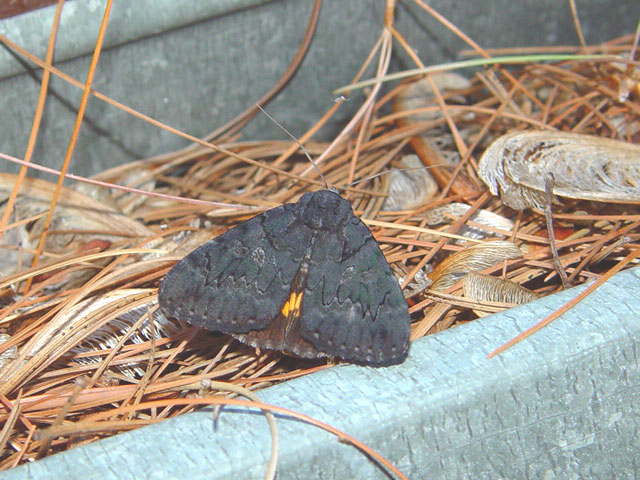
Catocala antinympha, July 18, 2006, Peterborough, Ontario,
courtesy of Tim Dyson
However, Gabe Larrabee writes (August 15, 2005,
"I have caught two specimens in one night so far in central
Wisconsin,
both males. They are actually common to abundant in certain areas of
Wisconsin where sweetfern grows, as I have been told by Leslie
Ferge."
Tom Middagh reports them from
Minnesota.
The very dark grey, almost black, forewing ground
colour distinguishes antinympha. There is some brown shading
in the subreniform spot and also just outside the postmedial line.
The hindwing is amber to pale orange.
Catocala antinympha is the same as C. paranympha Drury,
1773; affinis Westwood, 1837 and melanympha
Guenee, 1852
There is also the form multoconspicua Reiff, 1919 with a pale,
almost white subreniform spot. Catocala antinympha
at banana/beer bait, July 28, 2006, courtesy of
Tim Dyson, Peterborough, Ontario.
| 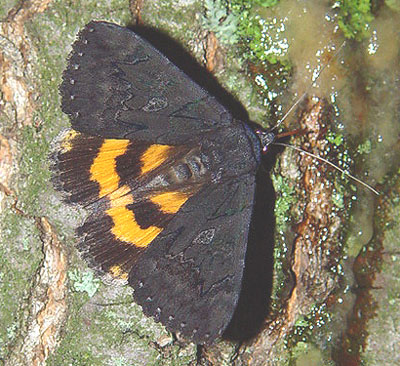 |
Tim Dyson operates an extensive bait trail which
he checks regularly throughout the summer and fall. He encounters many
of the lesser known forms.
To the right is Catocala antinympha "multiconspicua", observed
August 3, 2006, in Peterborough, Ontario.
The subreniform spot shows extensive white scaling on a forewing that
otherwise would be entirely dark. |
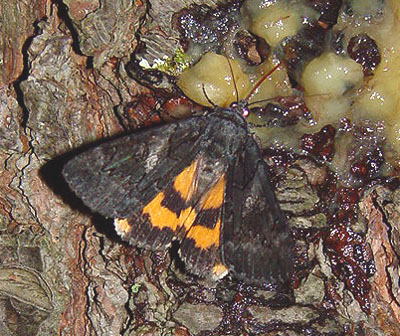 |
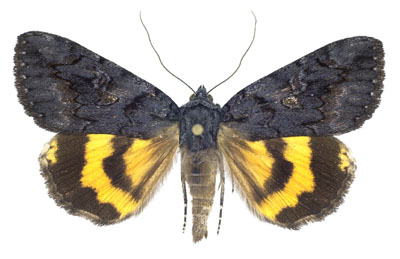
Catocala antinympha Canadian Biodiversity Information Facility
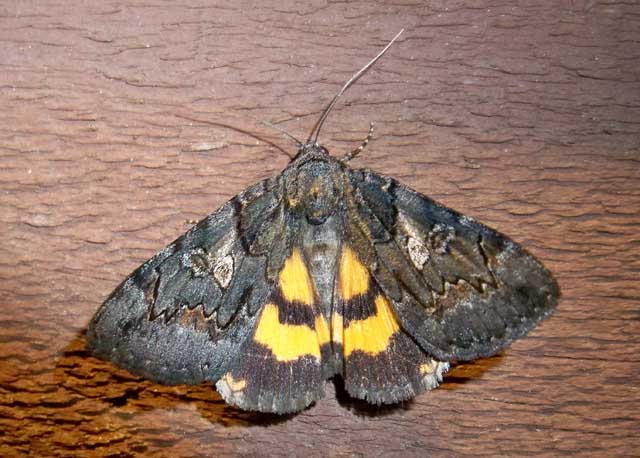
Catocala antinympha form multiconspicua, Sidney, Kennebec County, Maine,
July 29, 2011, courtesy of Steve Lemieux.
FLIGHT TIMES AND PREFERRED FOOD PLANTS:
In northern
portions of its range, Catocala antinympha flies as a single
generation with moths on the wing from mid July to mid September.
In more southerly locales there may be multiple flights, but it is
generally believed that all Catocala are univoltine (single
brooded).
Moths come in to lights readily and also to bait.
Tim Dyson sends this great shot, July 28, 2006, Peterborough,
Ontario. |
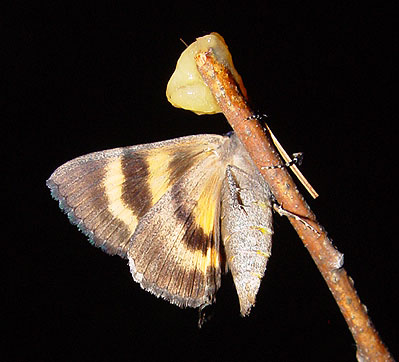 |
The Catocala antinympha caterpillar shows a preference for
Comptonia peregrina (sweetfern) and seems to be host specific.
ECLOSION:
Adults eclose from pupa formed in a very loose
cocoon amongst leaf litter.
SCENTING AND MATING:
Catocala antinympha females
emit an airbourne pheromone and males use their antennae to track the
scent plume.
EGGS, CATERPILLARS, COCOONS AND PUPAE:
Eggs are deposited on tree bark in the summer and fall and hatch the
following spring.
Generally pupation is in a very thinly constructed cocoon (just a few
strands of silk) amongst leaf litter near the base of the host plant.
Larval Food Plants
Listed below is the primary food plant.
It is hoped that this alphabetical listing followed by the common
name of the foodplant will prove useful. The list is not exhaustive,
although some species seem very host specific.
Experimenting with closely related foodplants is worthwhile.
Comptonia peregrina.....
|
Sweetfern
|
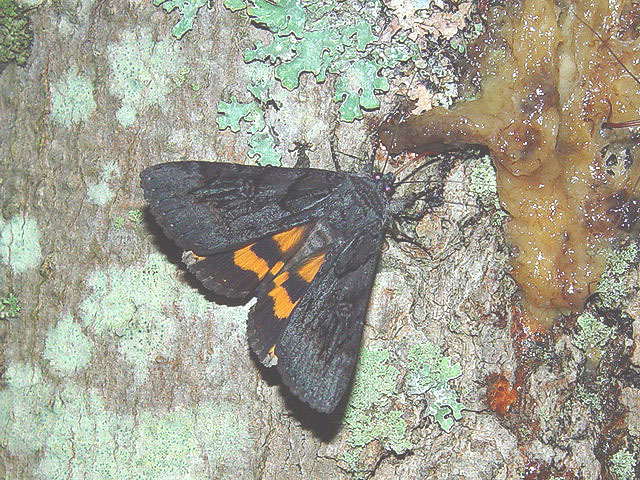
Catocala antinympha, July 27, 2006, Peterborough, Ontario,
courtesy of Tim Dyson
Return to Main Index
Visit Joe Garris's Catocala antinympha image, New Jersey.
Visit Deb Lievens's Catocala antinympha image, New Hampshire.
This page is brought to you by Bill Oehlke and the
WLSS. Pages are on space rented from Bizland. If you would like
to become a "Patron of the Sphingidae/Catocala Sites",
contact Bill.
Please send sightings/images to Bill. I will do my best to respond to requests for identification help.
Enjoy one of nature's wonderments: Live Saturniidae (Giant Silkmoth) cocoons.

|

To show appreciation for this site, click on the flashing
butterfly to the left, a link
to many worldwide insect sites. |







